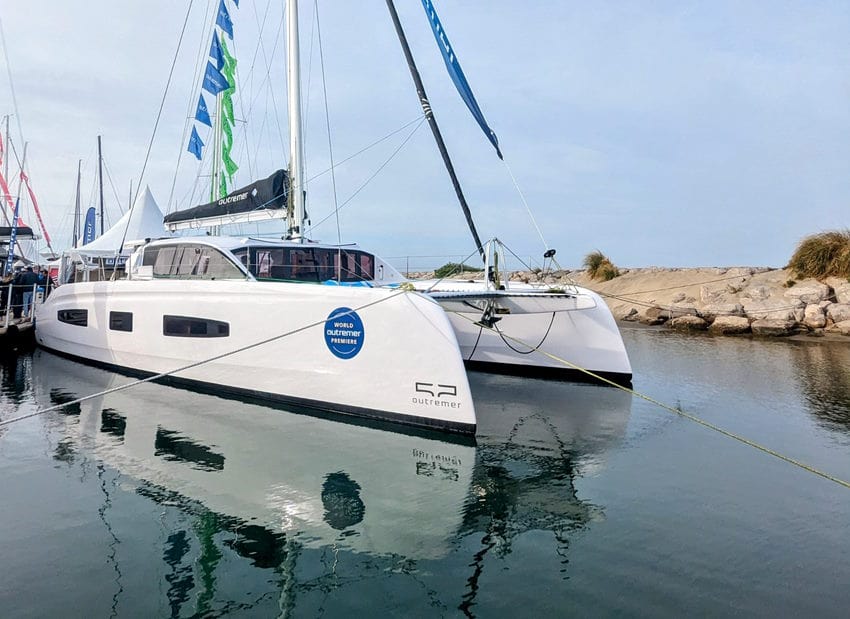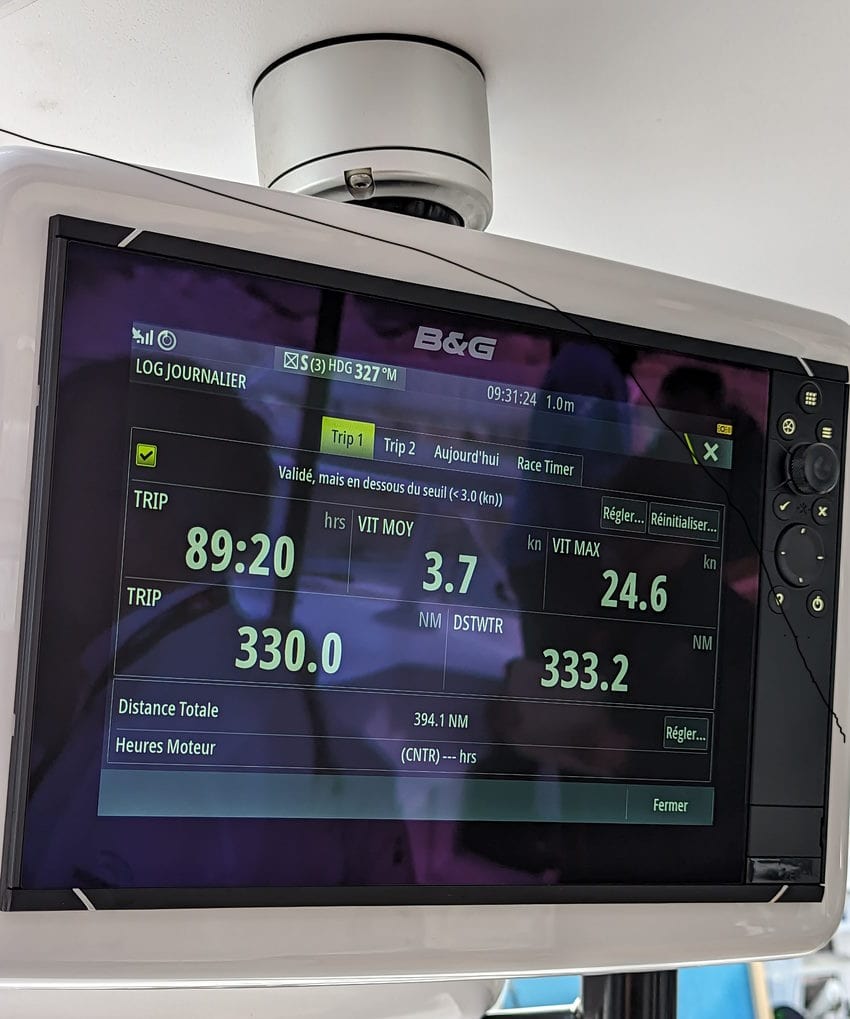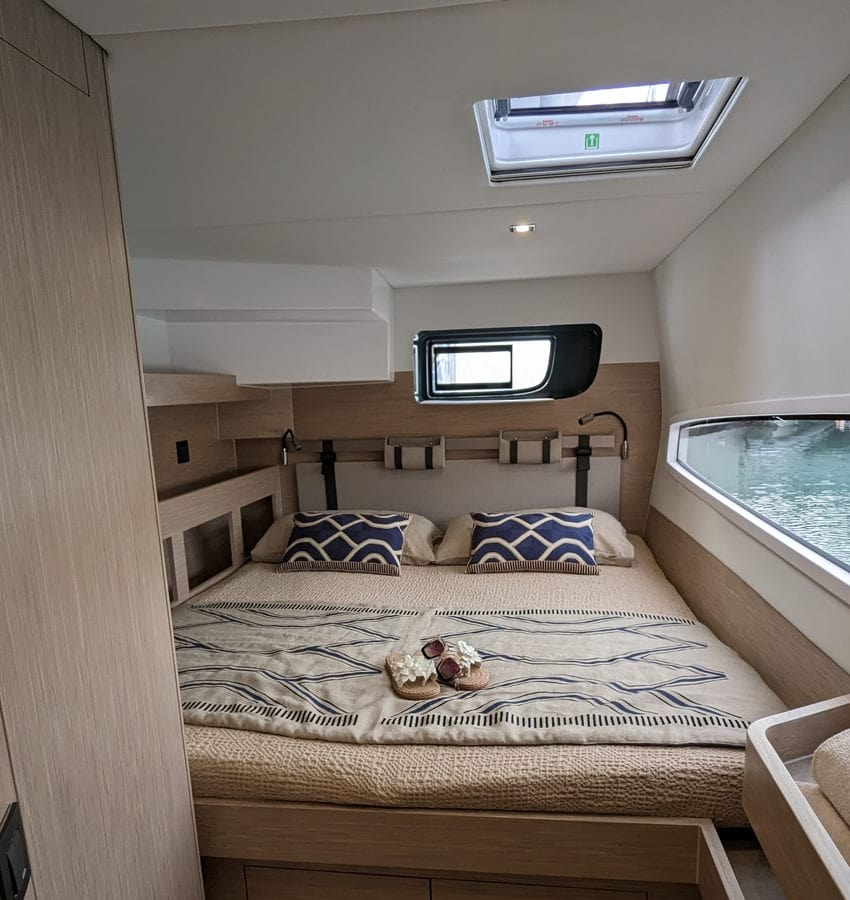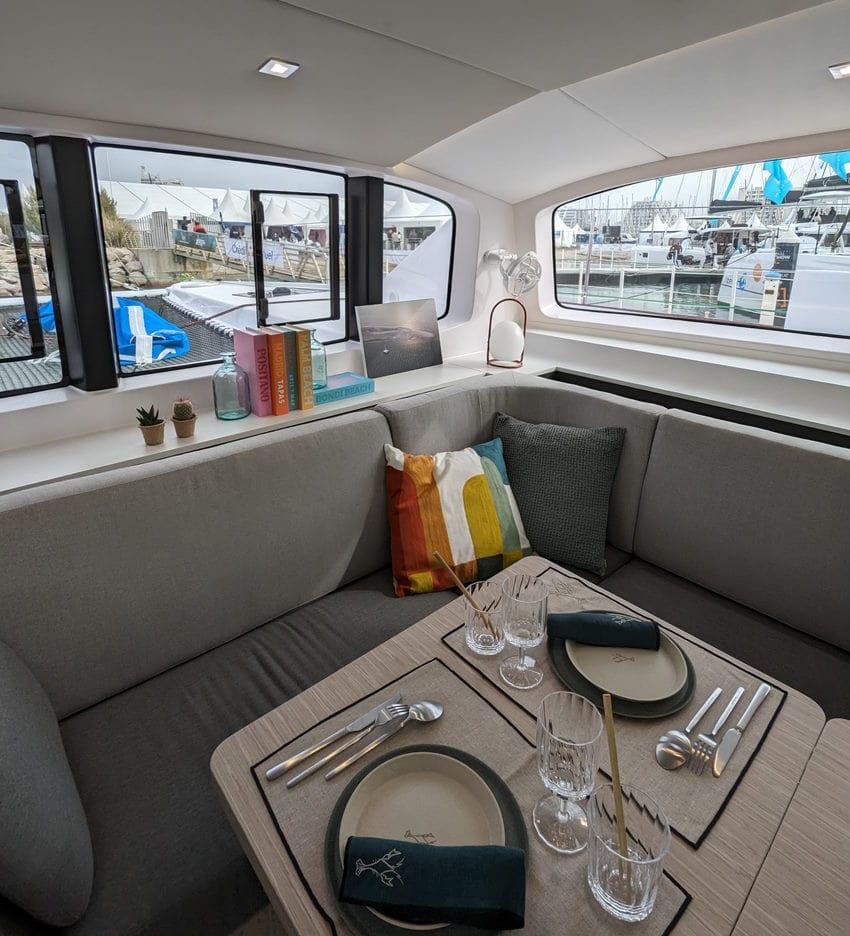Discussing the Outremer 52
Here are some notes from our discussions and the press conference at the International Multihull Show in La Grande Motte with Matthieu Rougevin-Baville – Commercial Director at Outremer.
This should give you some excellent insights into the development of this performance catamaran.
11 minute read

Top Sellers
“The 51 was our best seller so far with 100 boats sailing. And millions of miles sailed around the world, with families. Outremer is not a boat that you park in front of your house and sail on weekends. It’s usually a life project with your family.”
“And when you finish your project, you sell the boat to another family who will do the same. So the boats have an impressive average mileage, with several yachts with more than 2 million miles already. And to get a better boat, we ask many of our owners: “what could be improved?””
“And they came with a long list of possible improvements. And the experience we now have with Gunboat has also allowed us to bring plenty of improvements. The basic philosophy is that we want to reach a good performance level: not a racing boat, but we feel that being able to reach 10 knots of boat speed in 10 knots of wind is a good target.”
“That is more than enough for for a family project. We keep a huge safety margin because of course, the first thing people are looking, when they’re buying a Outremer, is always safety. That’s always the first request. So we want to be sure that even in a gusting wind, we stay very safe.”
Space
“To improve, the volume, the space, we need to save weight. That is what we have achieved in the last five years. Saving weight, not to fly a hull and be faster, but to hit the speed average that we aim for. We have managed to save almost one tonne from the boat structure that we have put back into the features.”
“Features like this big opening. Such as the taller higher windows: as you know, windows weigh more than composite. So we can soak up extra weight on this because we saved the weight on the structure and that is what allowed us to have such big openings.”
Safety
“The main feature on the Outremer 51 (the previous design) is the feeling of safety.
People wanted to feel safe because most of our Owners are families sailing long distances.”
“One feature, which is very appreciated on the 51 is the closed cockpit “U” shape, which is very secure. It’s easy to have a net behind and you can feel very protected, but the other thing people were asking for was an opening in the cockpit to be able to reach the transom, to go for swim more easily. On the 51 you need to climb on the deck and down on the transom.”
“We have an opening there, similar to the Outremer 45, but we have a moveable seat which is designed to secure the area on passage. So when you are in bad weather, with following seas it’s easy to close the area and you feel more safe with kids or even pets.”
“Of course, when you don’t need it you can bring it inside to have a continuous seating area around the cockpit or you can also flip it on its end and use it as a stool for the bar.”
Visibility
“We also wanted to improve the visibility. When you have a performance boat, it is very important to see what’s happening in front of you because you are covering a lot of distance. We wanted to offer this on all points of sail. The ability to clearly see what’s in front of you.”
“So if you are preparing food, having lunch you have a perfect visibility in front of you. When you are sitting in the cockpit, the sofa is orienteered length-ways. So if you need a 10m nap when you are doing your watch, it’s easy. You have a pillow behind your head and you see what’s in front of you every 10 minutes.
Of course, the forward facing chart table is ideal for visibility, if you need to send emails, or you are downloading the weather, or on watch in bad weather.”
Air-Flow
“Ventilation is also very important. You have four windows which are oriented so that you can direct the airflow in the direction you need. We tested it last week, it’s very efficient.”
Headroom
“We have more headroom: 10 centimetres higher for the entrance door, 10cm higher in the saloon. So there’s plenty of space because our customers are taller and taller.”
Protection
“One of the things that was requested from 51 customers, (and we also experienced that with the 55), is better protection in the cockpit.”
“You have two sets of steps in the 51, which means openings in the bimini top. So you have wind coming in, air turbulence around the coach roof when you are moving. On the 52, you can close this entire space with the sliding window and the clears. And regarding the ability to control the boat, we feel we have reached a very nice compromise.”
Versatile Helm
“So you notice the swing helm on the starboard side? You can use it on the deck, sitting on the bench, when conditions are nice, something that is appealing to Monohull sailors who want a good feeling in the elements with visibility forward. Most people keep it vertical coming into the marina.”
“My favourite position is slightly inwards because there you can control the helm from the cockpit but also from the deck with access to the winches. When you are at the helm, you have all your instruments, the sheets and access to the the controls.”
“And of course, you then can swing in to the fully inside position. You close up and bring the sheets inside: the cockpit can be fully closed with clears.”
“You still control the winches with 360 degrees visibility. I can tell you on the first test sailing in March, it was rather cold and we felt very comfy inside the cockpit.”
“Of course the table is convertible. You can make it into a bed, the same thing is possible inside. Convert it to a coffee table or have a nice home video place with a folding down screen.”
Storage
“When you are sailing far away with your family, you need plenty of storage.
With all the seating areas in the cockpit, you get storage. In the saloon as well, and we added storage under the floor, and you will see an extra bench.”
“In total on the 51 there is 1,100 litres of storage. On the 52, we have 1,700. We have added six hundred litres of storage. Just one of the smaller details that make a difference when you are living on a boat.”
Rain and Winches
“You can collect rain water from the bimini: the water comes down the pole in a pipe. If it’s clean, you can direct it to the water tanks.”
“The winches on the side are lower than the 51, so it is possible to winch manually without using the electric as you are in a better position.”
Accommodation
“The hulls are wider. They are not wider at waterline level, we have the same ratio of length to beam at that level, but they flare to give more space inside the hull. So the bed is lower. On the 51, the bed is higher, and you need a small step to climb in. We lowered it.”
Performance
“Because the structure of the boat is built differently, it’s stiffer. Using carbon we have even more stiffness than the 51 but also more space. It’s impressive on the water.”
“Some people were worried that the new boat would not sail as well as the older model. We are very happy to say that that’s not true.”

“From our the first trip, we covered 89.2 nautical miles with a maximum speed of 24.6. Very easy surfing and that was not pushing the boat, just the first sea trial. So yeah, we are very proud of the way the boat sails.”
“One of the differences between the 51 and the 52 is the mast was stepped backwards, So the mast is not on the front deck like on the 51, it’s now on the coach roof.”
“Of course, there is a carbon post to transmit the load from the mast to the bulkhead, but it gives you the ability to use the front deck. So, we have cushions covering the space and it’s very nice when you are sailing downwind being protected against the coach-roof.”
Longer bowsprit
“So, you can see that we have a longer bowsprit with a net in front for safer access. The ratio of weight to performance is the same as the 51 and it would be very interesting to see how the boat sails in the next Outremer Cup. We are very confident about the performance.”
Commercial Success
“The boat is a huge commercial success. I told you the 51 sold a hundred boats over ten years. The 52 has already sold more than fifty.”
“Some people were coming to buy a 51. We had to tell them that the 51 was about to stop. And then, the usual reaction was, “Can you show us some some details?”. And yeah, it was very successful.”
Production
“So for the moment, we have a capacity of 12 boats per year. The official delivery time is three to four years. But we plan to increase production to double the production of the boat within two years. So we expect the delivery time to be some time in 2025, with a new factory here, not far away.”
Solar
“How much solar? 2050W at peak times. 800 on the davits and 1300W on top.”

Dimensions
“The 52 is 40cm wider than the 51 and 15cm longer. Basically, what has happened in the last 15 years of boat design? Everything was moved backwards. The mast is slightly aft, the aft transom, the structural bulkhead.”
“So this is gives you the ability to increase the cockpit. But the main difference is in the rocker, the longitudinal curve of the boat to give it more stability at higher speeds.”
“So what we see in light, wind upwind there is not much difference with the 51 but in stronger wind downwind, the boat accelerates for a longer time and you have better average speed sailing downwind with plenty of stability.”
“The transoms are slightly wider in the back, which gives better access but also better buoyancy.”
Payload
“The official empty weight of the boat is 12.5 tonnes. We achieved less than that on the first boat, and of course, you can save weight with more carbon.”
“You have three main carbon bulkheads. They have to be carbon because the opening is so wide. We need a lot of strength in the corner and obviously on the front one, but you could add more carbon in the coach roof for extra weight saving. It’s a balance between saving more weight to get better performance or to compensate for more stuff and cost.”
Interiors
“You can have options like fake teak in the cockpit. We have 3 different options inside: three different types of wood finish and you have a choice of lots of upholstery: there are more than 100 different possibilities inside.”

“The front cabin options come from the 55. It’s what we call my “Free Space”. There are five different possibilities.”
“So, a standard double cabin, But you could also have an office with a foldable berth. And the upper part: two, foldable berths. Or you could have a walk-in dressing room, skipper’s carbon, kid’s cabin, etc. There are plenty of possibilities.”
“Usually, the owner’s cabin is on starboard, and the owner’s suite and the guest cabin will be on the other side. If you choose the four cabin version, you would have two guest cabins starboard. And usually the owner’s hull would then be on the port side where you could have a dressing room, with even more storage.”
“Of course, heating, air conditioning, gen set are all possible. You have two huge lockers in the front where you could have a gen set, a dive compressor or whatever’s needed. The average payload is three tonnes, which we feel is more than enough for a long distance blue-water sailing yacht.”
A Boat for Racing As Well?
“We always have people coming from both worlds: racing and cruising. And the predicted polars from VPLP are very encouraging.”
“If you want to go for performance, i.e. not having too many options, you will get an even better result that the performing 51. So the boat can be sailing at faster than wind speed until 12, 13 knots. So yeah, it’s very encouraging.”
Is there an option to have wheels on both sides?
“No, just one wheel with an optional tiller on the port side. What we wanted to improve from the 51 is the helm. We have a double bench which is very appreciated on the 55 and it works even better on the 52.”
“Everybody wanted to keep it because the angle is just perfect. If you want to test it, it’s a very comfortable position. Even if you’re not steering, but just to enjoy the view.”
Can you have a tiller on the starboard side?
“Actually, we could in theory have a tiller there as there is the same fitting on that side but the thing is, you have the bench and you have the standing post. So the angle would be very small, it doesn’t really make sense.”
Did you test the reaching angle?
“We beat to wind within ninety degrees on our test sail. The water was flat, wind from the north. We had 15 knots of true wind, we were sailing at 50 degrees, at 10.1 knots. The boat can reach 45 degrees In good conditions. When there’s wind and flat water.”
“We beat almost all monohulls except the real racing ones, of course, we will not compete.”
“We had two clients test the boat on Saturday and both of them have made an order. 100% Conversion! So far, so good.”
“We’re very proud of the result so far. It’s very successful. I think we have the best compromise to please both experienced sailors and people who don’t care about sailing at 20 knots, who want a space that they can enjoy.”

